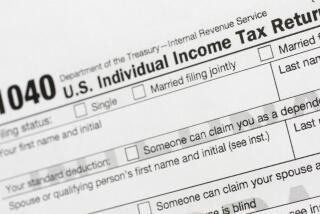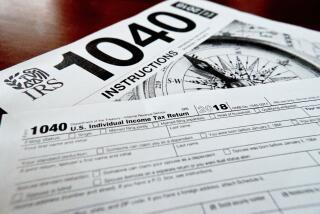The Dos and Don’ts of Electronic Tax Filing
- Share via
Christmas is about the worst time to think about filing tax returns. But soon the Internal Revenue Service will be mailing out those dreaded 1040s, this time with a new pitch: File electronically, and you’ll get your refund much faster.
Next year for the first time, taxpayers in all 50 states will be able to file tax returns electronically through computer linkups between authorized companies and the IRS. If you decide to use this service, however, be sure to shop around for the best deals; fees vary widely. And be wary of some deals that promise to get you your refund even faster through so-called refund anticipation loans.
Electronic filing is not new, having been introduced in 1986 on an experimental basis in selected markets. Each year it has become available in more cities. Last year about 1.2 million returns were processed electronically through nearly 14,000 IRS-approved firms.
In the Los Angeles area, however, it does not seem to have caught on yet. In this past year’s filing season--the first time electronic filing was available here--only 5,500 taxpayers used the procedure, says Carole Levitzky, public affairs specialist at the IRS district office in Los Angeles.
The IRS, which plans a big promotional push this season to encourage electronic filing, hopes usage will improve. It expects the number of returns filed electronically to nearly double in the upcoming tax season, to about 2 million. And in five years, some experts predict, the procedure will be used by as many as 30 million taxpayers.
“By the year 1995, electronic filing will be the normal, accepted means of filing your individual and business tax returns, and by 2000, the IRS will be 98% paper-free,” predicts David Green, managing partner of Alder, Green & Hasson, a Los Angeles accounting firm.
There are two key advantages to electronic filing:
- Quicker refunds. Electronic filers can get their refunds in three weeks, versus the normal six to 10 weeks for paper filers. If you have a direct deposit arrangement with a bank--whereby the IRS can deposit your refund directly into your savings or checking account--you can get your refund in as little as two weeks.
In the Los Angeles area last year, the average refund on electronic returns totaled $1,487--a nice amount of change to get a month sooner.
- Fewer errors. The IRS-approved software used to file electronically will identify math mistakes. The error rate on electronic returns is only 3%, versus 16% for paper returns, the IRS says.
How do you file electronically?
You can’t do it by yourself. Instead, you have to do it through a tax preparer, bank, computer firm or other outfit approved by the IRS; they vary from mom-and-pop street-corner CPA firms, to giant national chains like H&R; Block, to companies peddling tax-preparation software. If you do your own taxes on your personal computer using suitable tax-preparation software, you can take or send your diskette to some services. Some will file your return electronically if you fax your forms in.
In the Los Angeles area, some 1,060 firms have been authorized to offer electronic filing for the upcoming season, up from about 660 in the 1989 season, the IRS’s Levitzky says.
Call around, so you can also comparison shop for the best price and service. Fees can run as low as $5 to well over $50.
Also, some electronic filing firms are offering to lend you the amount of your expected refund. Fees for these refund anticipation loans can easily run over $50. That can be equivalent to an annual interest rate of well over 100% --just for getting the use of your money a few days early. Is that really worth it?
More to Read
Inside the business of entertainment
The Wide Shot brings you news, analysis and insights on everything from streaming wars to production — and what it all means for the future.
You may occasionally receive promotional content from the Los Angeles Times.










